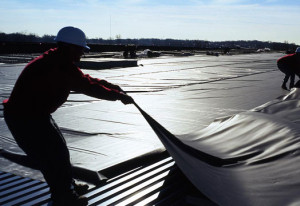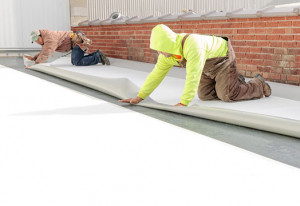Commercial Roof Installation
Springer Brothers, Inc. has been installing and repairing commercial roofs in the Delaware Valley for the past 40 years. Our fully staffed office is always available to set up appointments for “Free Estimates” with our Roofing Experts. Our expertise on commercial buildings includes but is not limited to:
- E.P.D.M
- Hot Roofing
- Modified
- T.P.O.
EPDM: Ethylene Propylene Diene Monomer
 EPDM: Ethylene Propylene Diene Monomer (or Terpolymer which is simply a product consisting of three distinct monomers). EPDM is classified as a Thermoset material which means it is either fully-cured prior to being installed or that it cures during natural weathering after installation. EPDM roofs are single-ply membranes meaning there is only one ply of roofing material, not multiple plies laminated together.
EPDM: Ethylene Propylene Diene Monomer (or Terpolymer which is simply a product consisting of three distinct monomers). EPDM is classified as a Thermoset material which means it is either fully-cured prior to being installed or that it cures during natural weathering after installation. EPDM roofs are single-ply membranes meaning there is only one ply of roofing material, not multiple plies laminated together.
EPDM has been in use on roofs in the USA since the 1960’s and is one of the most common types of low-slope roofing materials. This is because it is relatively inexpensive, simple to install, and fairly clean to work with when compared to conventional built-up roofs. There aren’t the odors and fumes that accompany built-up roofs which appeals to many property owners and managers.
EPDM is a rubber material whose principal components consist of the compounds ethylene and propylene. A flexible rubber matrix forms when a small amount of diene is added to the mix. EPDM is available reinforced or unreinforced with both commonly used; it’s also available in either a cured (vulcanized) or uncured (non-vulcanized) state. Vulcanized EPDM is the most common with non-vulcanized often used for flashing purposes.
EPDM membrane thickness ranges from thirty mils (0.030″) to one-hundred mils (0.100″) with the most common thicknesses being forty-five mils (0.045″) and sixty mils (0.060″). There are three standard application procedures: (1) fully-adhered; (2) mechanically-fastened; (3) loose-laid. Fully-adhered EPDM uses water or solvent-based adhesives to adhere the rubber to the substrate. Mechanically-fastened EPDM is attached by manufacturer-approved mechanical means to the substrate, and loose-laid membranes are secured only at the perimeters and any penetrations. A ballast of round river rock or concrete pavers is used to hold the materials in place. River rock is usually installed at a rate of 1000 – 1200 pounds per roof square (100 square feet) and the pavers generally weigh approximately 20 pounds per square foot. Structural integrity is important with loose-laid roof systems. The seams of all systems are then sealed using either an adhesive or a splice tape. Splice tapes have tested with a higher tear-strength.
TPO: Thermoplastic Olefin or Polyolefin
 TPO membranes are single-ply roof membranes constructed from ethylene propylene rubber. They are designed to combine the durability of rubber with the proven performance of hot-air weldable seams. They have been tested as having excellent resistance to ozone, are algae-resistant, environmentally friendly and safe to install. The material’s manufacturers are so confident in properly welded seams that the material is sometimes advertised as a monolithic (seamless) roof. Seam strengths are reportedly 3 to 4 times those of EPDM’s adhesive and tape seams. TPO is highly resistant to tears, impacts, and punctures with good flexibility to allow for building movement. TPO’s are available in white, light gray, and black with thicknesses of either 45 mils (.045″) or 60 mils (.060″). The width of the membrane depends on the manufacturer but they usually come in widths of six to six-and-a-half feet and are one-hundred feet in length.
TPO membranes are single-ply roof membranes constructed from ethylene propylene rubber. They are designed to combine the durability of rubber with the proven performance of hot-air weldable seams. They have been tested as having excellent resistance to ozone, are algae-resistant, environmentally friendly and safe to install. The material’s manufacturers are so confident in properly welded seams that the material is sometimes advertised as a monolithic (seamless) roof. Seam strengths are reportedly 3 to 4 times those of EPDM’s adhesive and tape seams. TPO is highly resistant to tears, impacts, and punctures with good flexibility to allow for building movement. TPO’s are available in white, light gray, and black with thicknesses of either 45 mils (.045″) or 60 mils (.060″). The width of the membrane depends on the manufacturer but they usually come in widths of six to six-and-a-half feet and are one-hundred feet in length.
TPO membranes are installed fully-adhered, mechanically-attached or ballasted. Fully-adhered means that the roof is “glued” to the substrate using a special adhesive. What actually happens is the glue creates a chemical bond with the membrane. Ballasted simply means the membrane is loose laid over the top of the roof, sealed at all penetrations and around the perimeter, and then a ballast is put on it to hold it in place. Ballast usually consists of smooth, round, river rock 2″ – 3″ in diameter and is applied at a rate of 1,000 to 1,200 pounds per roof square (100 sq. ft.). Sometimes concrete pavers are used in their place. These average 20 pounds per square foot. Mechanically-attached membranes are those that use some type of special screw-type fastener to secure it. The type of fastener will depend on the type of substrate but all fasteners are generally screw-type fasteners.
- Flat
- Rubber Covering
- Slate
- Membrane Systems
- Installation Solutions
We can handle any kind of construction project, replacement materials, company buildings and commercial house projects. The Better Business Bureau recognizes quality companies and contractors and we are proud to be a member of their organization.
